Effect of the Addition of Biobased Polyols on the Thermal Stability and Flame Retardancy of Polyurethane and Poly(urea)urethane Elastomers
Abstract
:1. Introduction
2. Experimental
2.1. Materials
- Elastomers with the tall-oil-based polyol:
- Elastomers with the soybean-oil-based polyol:
- Elastomers with the rapeseed-oil-based polyol:
2.2. Methods
3. Results and Discussion
3.1. Thermal Properties
3.2. Burning Behavior
3.3. Analysis of Char Residues after the Cone Calorimeter Test
3.4. Characterization of the Decomposition Products
4. Conclusions
Author Contributions
Funding
Institutional Review Board Statement
Informed Consent Statement
Data Availability Statement
Acknowledgments
Conflicts of Interest
References
- Srivastava, S.K.; Kuila, T. Chapter 18—Fire Retardancy of Elastomers and Elastomer Nanocomposites. In Polymer Green Flame Retardants; Elsevier: Amsterdam, The Netherlands, 2014; pp. 597–651. [Google Scholar] [CrossRef]
- Nikje, M.M.A. Polyurethane foams (PUF) containing components obtained in microwave assisted recycling processes of polyurethane waste and liquefaction of starch. Polimery 2012, 57, 11–17. [Google Scholar] [CrossRef]
- Prociak, A.; Michałowski, S.; Bąk, S. Thermoplastic polyurethane foamed using microwave radiation. Polimery 2012, 57, 786–790. [Google Scholar] [CrossRef]
- Kukfisz, B.; Półka, M. Analysis of oxygen index to support candle-like combustion of polyurethane. Eng. Proc. 2017, 172, 604–611. [Google Scholar] [CrossRef]
- Janik, H.; Balas, A. Chemical structure and physical properties of cured polyurethanes segment. Polimery 2009, 54, 195–201. [Google Scholar] [CrossRef] [Green Version]
- Kotal, M.; Srivastava, S.K.; Manu, S.K.; Saxena, A.K.; Pandey, K.N. Preparation and properties of in-situ polymerized polyurethane/stearate intercalated layer double hydroxide nanocomposites. Polym. Int. 2013, 62, 728–735. [Google Scholar] [CrossRef]
- Sharma, V.; Kundu, P.P. Condensation polymers from natural oils. Prog. Polym. Sci. 2008, 33, 1199–1215. [Google Scholar]
- Chattopadhyay, D.K.; Raju, K.V. Structural engineering of polyurethane coatings for high performance applications. Prog. Polym. Sci. 2007, 32, 352–418. [Google Scholar] [CrossRef]
- Yumurtaci, M.; Kecebas, A. Renewable energy and its university level education in Turkey. Energy Educ. Sci. Technol. Part B Soc. Educ. Stud. 2011, 3, 143–152. [Google Scholar]
- Prasanth, K.S.P.; Mohanan, A.; Bouzidi, L.; Narine, S.S. Phase behavior of novel triacylglycerols derived from metathesis modified plant oils. Ind. Crops Prod. 2016, 94, 431–444. [Google Scholar]
- Corre, W.J.; Conijn, J.G.; Meesters, K.P.H.; Bos, K.L. Accounting for co-products in energy use, greenhouse gas emission savings and land use of biodiesel production from vegetable oils. Ind. Crops Prod. 2016, 80, 220–227. [Google Scholar] [CrossRef]
- Gaidukova, G.; Ivdre, A.; Fridrihsone, A.; Verovkins, A.; Cabulis, U.; Gaidukovs, S. Polyurethane rigid foams obtained from polyols containing bio-based and recycled components and functional additives. Ind. Crops Prod. 2017, 102, 133–143. [Google Scholar] [CrossRef]
- Pietrzak, K.; Kirpluks, M.; Cabulis, U.; Ryszkowska, J. Effect of the addition of tall oil-based polyols on the thermal and mechanical properties of ureaurethane elastomers. Polym. Degrad. Stab. 2014, 108, 201–211. [Google Scholar] [CrossRef]
- Mizera, K.; Kirpluks, M.; Cabulis, U.; Leszczyńska, M.; Półka, M.; Ryszkowska, J. Characterisation of ureaurethane elastomers containing tall oil based polyols. Ind. Crops Prod. 2018, 113, 98–110. [Google Scholar] [CrossRef]
- Mizera, K.; Ryszkowska, J. Polyurethane elastomers from polyols based on soybean oil with a different molar ratio. Polym. Degrad. Stab. 2016, 132, 21–31. [Google Scholar] [CrossRef]
- Mizera, K.; Ryszkowska, J. Thermal properties of polyurethane elastomers from soybean oil-based polyol with a different isocyanate index. J. Elast. Plast. 2019, 51, 157–174. [Google Scholar] [CrossRef]
- Mizera, K.; Ryszkowska, J.; Kuranska, M.; Prociak, A. Characterisation of ureaurethane elastomers with rapeseed oil-based polyol. IOP Conf. Ser. Mater. Sci. Eng. 2019, 500, 012015. [Google Scholar] [CrossRef]
- Mizera, K.; Ryszkowska, J.; Kuranska, M.; Prociak, A. The effect of rapeseed oil-based polyols on the thermal and mechanical properties of ureaurethane elastomers. Polym. Bull. 2020, 77, 823–846. [Google Scholar] [CrossRef] [Green Version]
- Mizera, K.; Ryszkowska, J.; Kuranska, M.; Prociak, A. Production and characterization of ureaurethane elastomers with rapeseed based polyol. Polym. Int. 2018, 67, 1605–1614. [Google Scholar] [CrossRef]
- Kotal, M.; Srivastava, S.K.; Bhowmick, A.K. Thermoplastic polyurethane and nitrile butadiene rubber blends with layered double hydroxide nanocomposites by solution blending. Polym. Int. 2010, 59, 2–10. [Google Scholar] [CrossRef]
- Alcon, M.J.; Ribera, G.; Galia, M.; Cadiz, V. Synthesis, characterization and polymerization of isobutylbis(glycidylpropylether) phosphine oxide. Polymer 2003, 44, 7291–7298. [Google Scholar] [CrossRef]
- Liaw, D.-J.; Lin, S.-P. Phosphorus-containing polyurethanes based on bisphenol-AF, prepared by N-akylation. J. Appl. Polym. Sci. 1996, 61, 315–319. [Google Scholar] [CrossRef]
- Guner Seniha, F.; Yagci, Y.; Erciyes Tuncer, A. Polymers from triglyceride oils. Prog. Polym. Sci. 2006, 31, 633–670. [Google Scholar] [CrossRef]
- Bourbigot, S.; Duquesne, S. Char formation and characterization. In Fire Retardancy of Polymeric Materials; Wilkie, C.A., Morgan, A.B., Eds.; CRC Press: New York, NY, USA, 2010; pp. 239–260. [Google Scholar]
- Nyambo, C.; Kandare, E.; Wilkie, C.A. Thermal stability and flammability characteristics of ethylene vinyl acetate (EVA) composites blended with a phenyl phosphonate-intercalated layered double hydroxide (LDH), melamine polyphosphate and/or boric acid. Polym. Degrad. Stab. 2009, 94, 513–520. [Google Scholar] [CrossRef] [Green Version]
- Zhao, C.X.; Liu, Y.; Wang, D.Y.; Wang, D.L.; Wang, Y.Z. Synergistic effect of ammonium polyphosphate and layered double hydroxide on flame retardant properties of poly(vinyl alcohol). Polym. Degrad. Stab. 2008, 93, 1323–1331. [Google Scholar] [CrossRef]
- ISO 5660-1:2015. Reaction-to-Fire Tests—Heat Release, Smoke Production and Mass Loss Rate—Part 1: Heat Release Rate (Cone Calorimeter Method) and Smoke Production Rate (Dynamic Measurement); ISO: Geneva, Switzerland, 2015. [Google Scholar]
- Trzebiatowska, P.J.; Deuter, I.; Datta, J. Cast polyurethanes obtained from reactive recovered polyol intermediates via crude glycerine decomposition process. React. Funct. Polym. 2017, 119, 20–25. [Google Scholar] [CrossRef]
- Das, S.; Konwar, U.; Mandal, M.; Karak, N. Sunflower oil based biodegradable hyperbranched polyurethane as a thin film material. Ind. Crops Prod. 2013, 44, 396–404. [Google Scholar] [CrossRef]
- Ye, L.; Meng, X.Y.; Ji, X.; Li, Z.M.; Tang, J.H. Synthesis and characterization of expandable graphite-poly(methyl methacrylate) composite particles and their application to flame retardation of rigid polyurethane foams. Polym. Degrad. Stab. 2009, 94, 971–979. [Google Scholar] [CrossRef]
- McKenna, S.T.; Hul, T.R. The fire toxicity of polyurethane foams. Fire Sci. Rev. 2016, 5, 3. [Google Scholar] [CrossRef] [Green Version]
- Kirpluks, M.; Cabulis, U.; Kurańska, M.; Prociak, A. Three different approaches for polyol synthesis from rapeseed oi. Key Eng. Mater. 2013, 559, 69–74. [Google Scholar] [CrossRef]
- Valero, M.F.; Pulido, J.E.; Hernandez, J.C.; Posada, J.A.; Ramirez, A.; Cheng, Z. Preparation and Properties of Polyurethanes based on Castor Oil Chemically Modified with Yucca Starch Glycoside. J. Elast. Plast. 2009, 41, 223–244. [Google Scholar] [CrossRef]
- Stirna, U.; Sevastyanova, I.; Misane, M.; Cabulis, U.; Beverte, I. Structure and properties of polyurethane foams obtained from rapeseed oil polyols. Proc. Estonian Acad. Sci. Chem. 2006, 55, 101–109. [Google Scholar]
- Wang, X.; Hu, Y.; Song, L.; Yang, H.; Yu, B.; Kandola, B.; Deli, D. Comparative study on the synergistic effect of POSS and graphene with melamine phosphate on the flame retardance of poly(butylene succinate). Thermochim. Acta 2012, 543, 156–164. [Google Scholar] [CrossRef]
- Demirbas, A. Methylation of wood fatty and resin acids form production of biodiesel. Fuel 2011, 90, 2273–2279. [Google Scholar] [CrossRef]
- Günther, M.; Levchik, S.V.; Schartel, B. Bubbles and collapses: Fire phenomena of flame-retarded flexible polyurethane foams. Polym. Adv. Technol. 2020, 31, 2185–2198. [Google Scholar] [CrossRef]
- Akdogan, E.; Erdem, M.; Erdem Ureyen, M.; Kaya, M. Synergistic effects of expandable graphite and ammonium pentaborate octahydrate on the flame-retardant, thermal insulation, and mechanical properties of rigid polyurethane foam. Polym. Comp. 2020, 41, 1749–1762. [Google Scholar] [CrossRef]
- Sałasińska, K.; Borucka, M.; Celiński, M.; Gajek, A.; Zatorski, W.; Mizera, K.; Leszczyńska, M.; Ryszkowska, J. Thermal stability, fire behavior, and fumes emission of polyethylene nanocomposites with halogen-free fire retardants. Adv. Polym. Technol. 2018, 37, 2394–2410. [Google Scholar] [CrossRef]
- Kong, Q.H.; Wu, T.; Zhang, H.K.; Zhang, Y.; Zhang, M.M.; Si, T.Y.; Yang, L.; Zhang, J.H. Improving flame retardancy of IFR/PP composites through the synergistic effect of organic montmorillonite intercalation cobalt hydroxides modified by acidified chitosan. Appl. Clay Sci. 2017, 146, 230–237. [Google Scholar] [CrossRef]
- Zhang, J.H.; Kong, Q.H.; Yang, L.W.; Wang, D.Y. Few layered Co(OH)(2) ultrathin nanosheet-based polyurethane nanocomposites with reduced fire hazard: From ecofriendly flame retardance to sustainable recycling. Green Chem. 2016, 18, 3066–3074. [Google Scholar] [CrossRef]
- Altiparmak, D.; Keskin, A.; Koca, A.; Guru, M. Alternative fuel properties of tall oil fatty acid methyl ester-diesel fuel blends. Bioresour. Technol. 2017, 98, 241–246. [Google Scholar] [CrossRef] [PubMed]
- Lubguban, A.A.; Balangao, A.J.G.; Aquiatan, R.H.; Paclijan, S.; Magadan, K.O.; Balangao, J.K.B.; Escalera, S.T.; Bayron, R.R.; Debalucos, B.; Lubguban, A.A.; et al. Soy-Based Polyols and Polyurethanes. Kimika 2017, 28, 1–19. [Google Scholar] [CrossRef] [Green Version]
- Giorcelli, M.; Savi, P.; Khan, A.; Tagliaferro, A. Analysis of biochar with different pyrolysis temperatures used as filler in epoxy resin composites. Biomass Bioenergy 2019, 122, 466–471. [Google Scholar] [CrossRef]
- Wen, Y.; Cheng, Z.; Li, W.; Li, Z.; Liao, D.; Hu, X.; Pan, N.; Wang, D.; Hull, T.R. A novel oligomer containing DOPO and ferrocene groups: Synthesis, characterization, and its application in fire retardant epoxy resin. Polym. Degrad. Stab. 2018, 156, 111–124. [Google Scholar] [CrossRef]
- Cervantes-Uc, J.M.; Moo Espinosa, J.I.; Cauich-Rodríguez, J.V.; Avila-Ortega, A.; Vazquez-Torres, H.; Marcos-Fernandez, A.; San Roman, J. TGA/FTIR studies of segmented aliphatic polyurethanes and their nanocomposites prepared with commercial montmorillonites. Polym. Degrad. Stab. 2009, 94, 1666–1677. [Google Scholar] [CrossRef]
- Ciecierska, E.; Jurczyk-Kowalska, M.; Bazarnik, P.; Kowalski, M.; Krauze, S.; Lewandowska, M. The influence of carbon fillers on the thermal properties of polyurethane foam. J. Therm. Anal. Calorim. 2016, 123, 283–291. [Google Scholar] [CrossRef] [Green Version]
- Salasinska, K.; Mizera, K.; Barczewski, M.; Borucka, M.; Gloc, M.; Celiński, M.; Gajek, A. The influence of degree of fragmentation of Pinus sibirica on flammability, thermal and thermomechanical behavior of the epoxy-composites. Polym. Test. 2019, 79, 106036. [Google Scholar] [CrossRef]

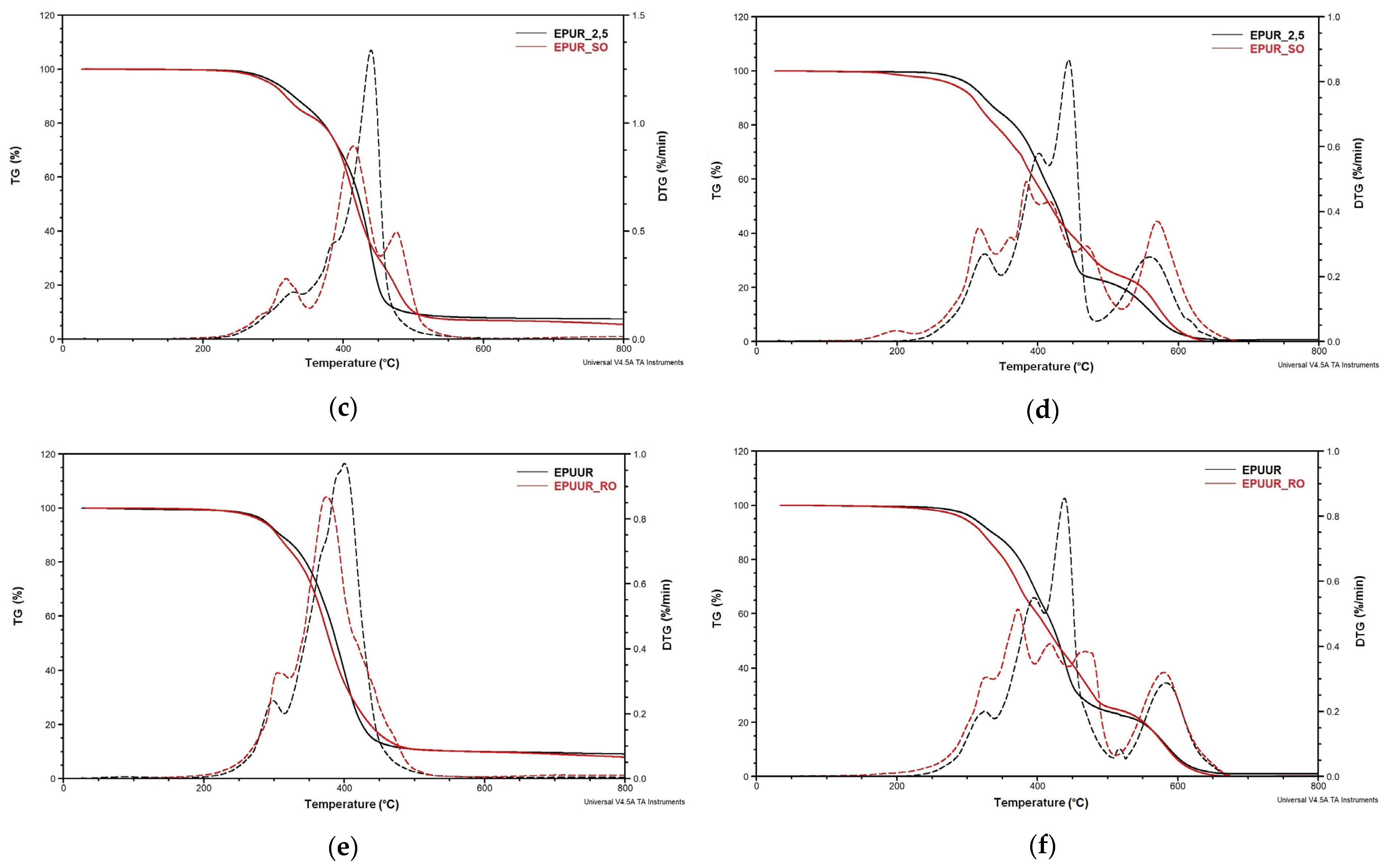


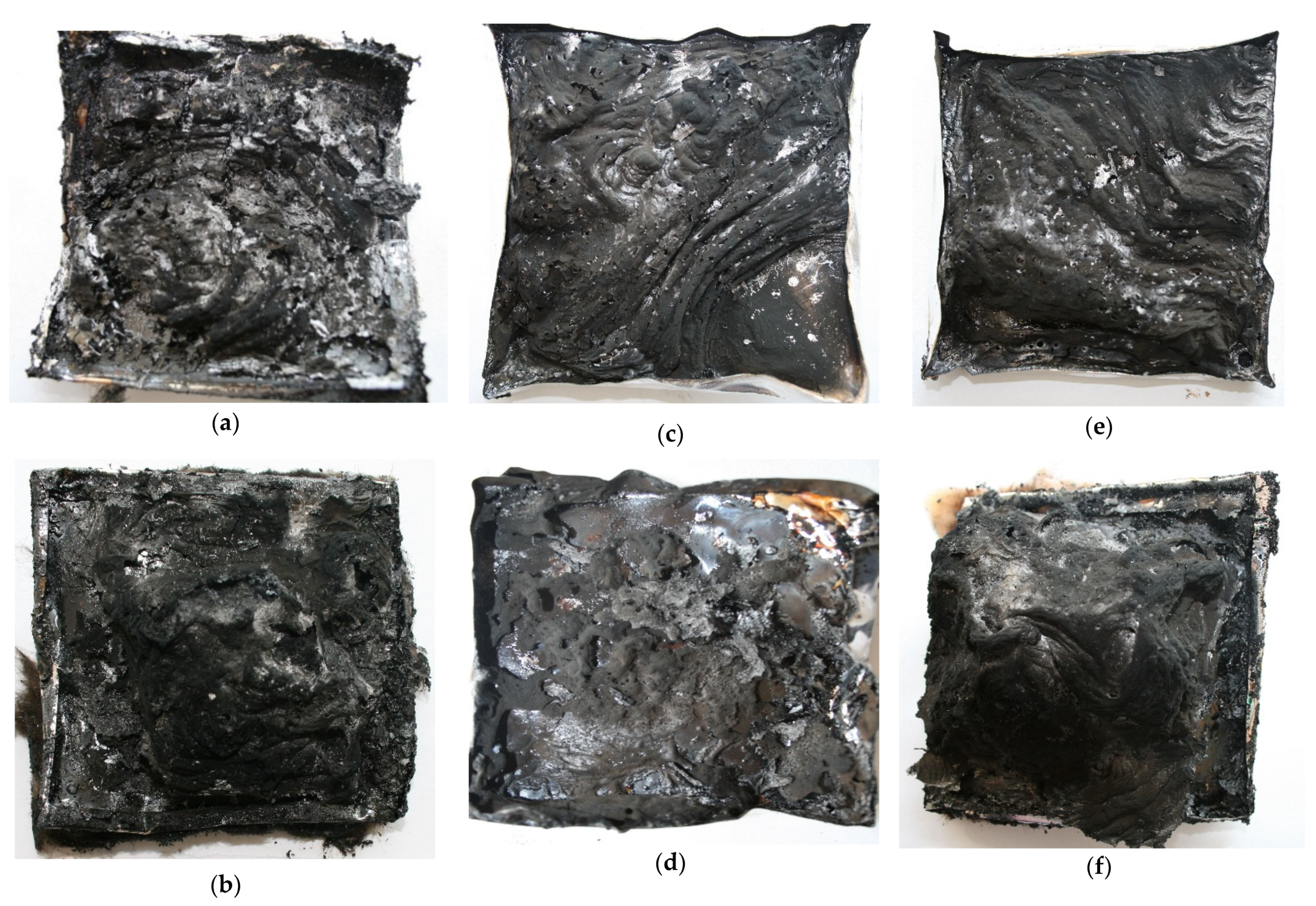
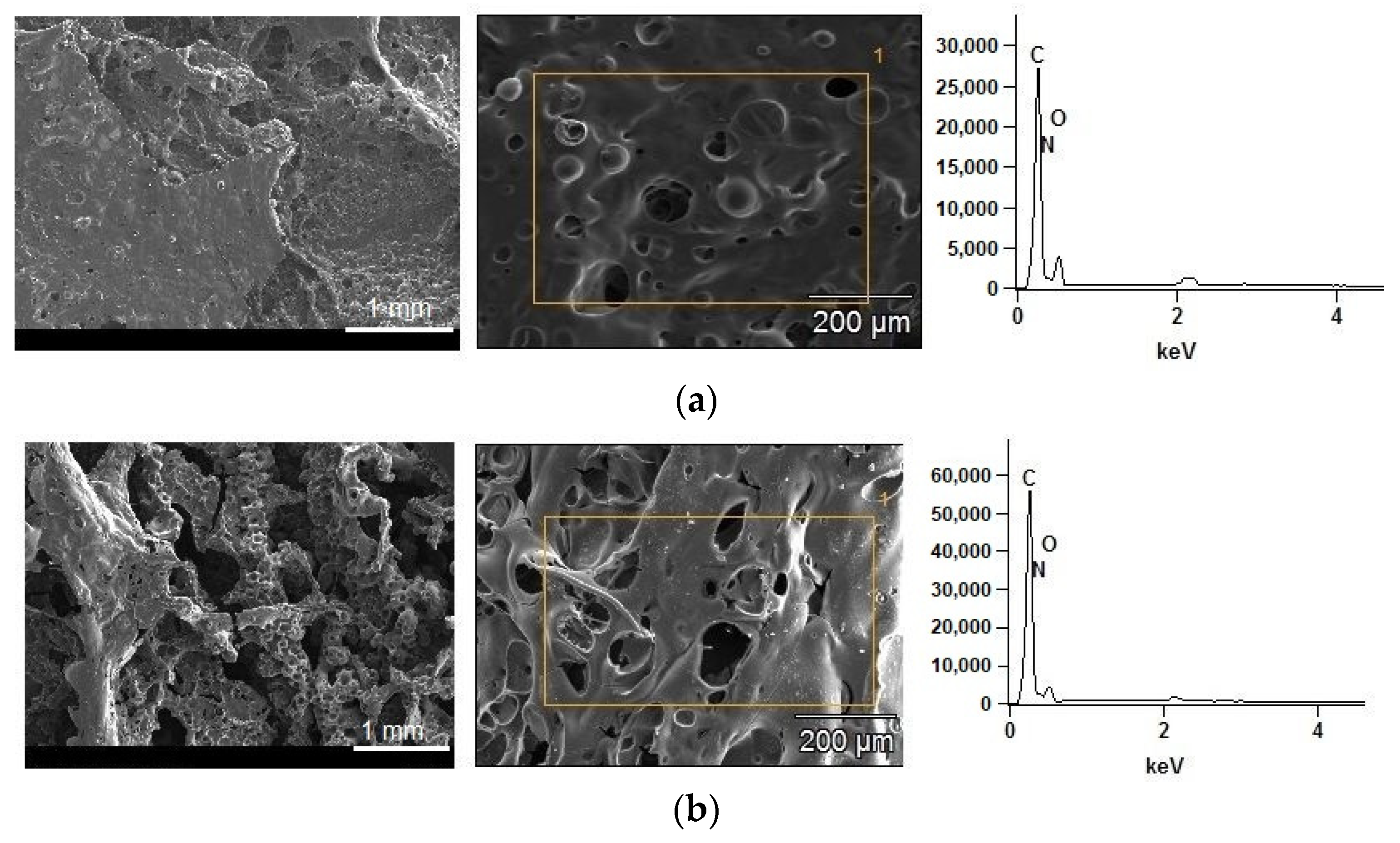

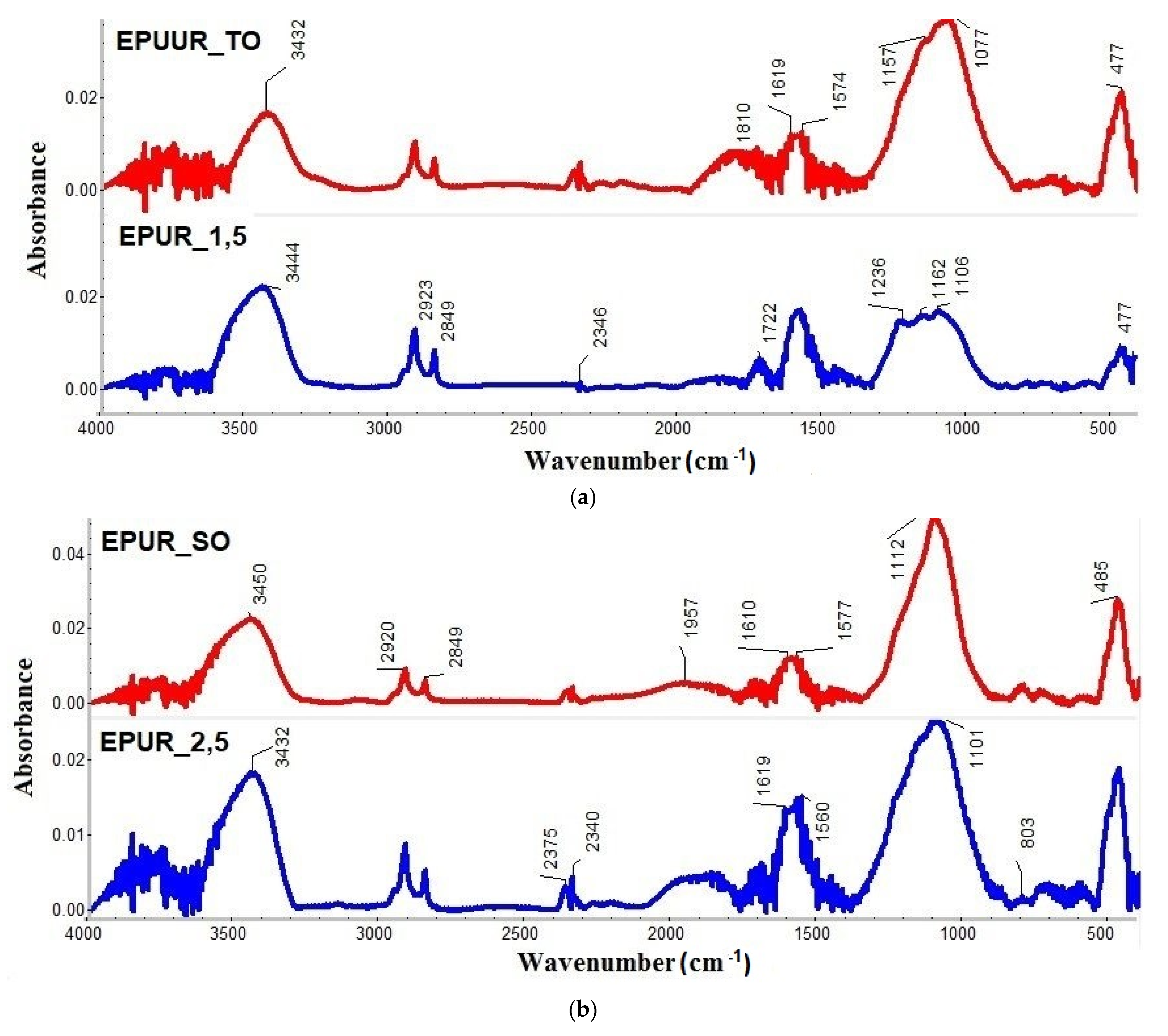
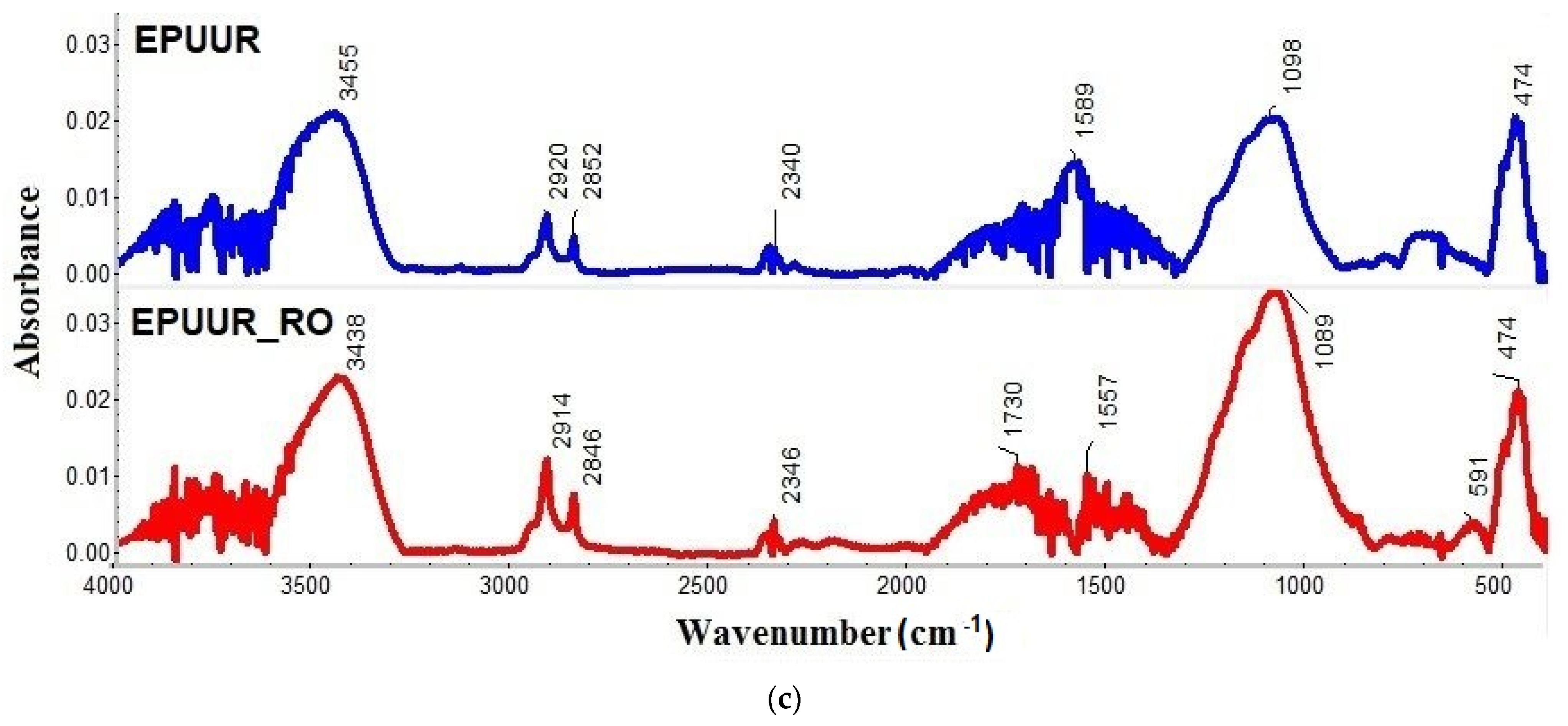



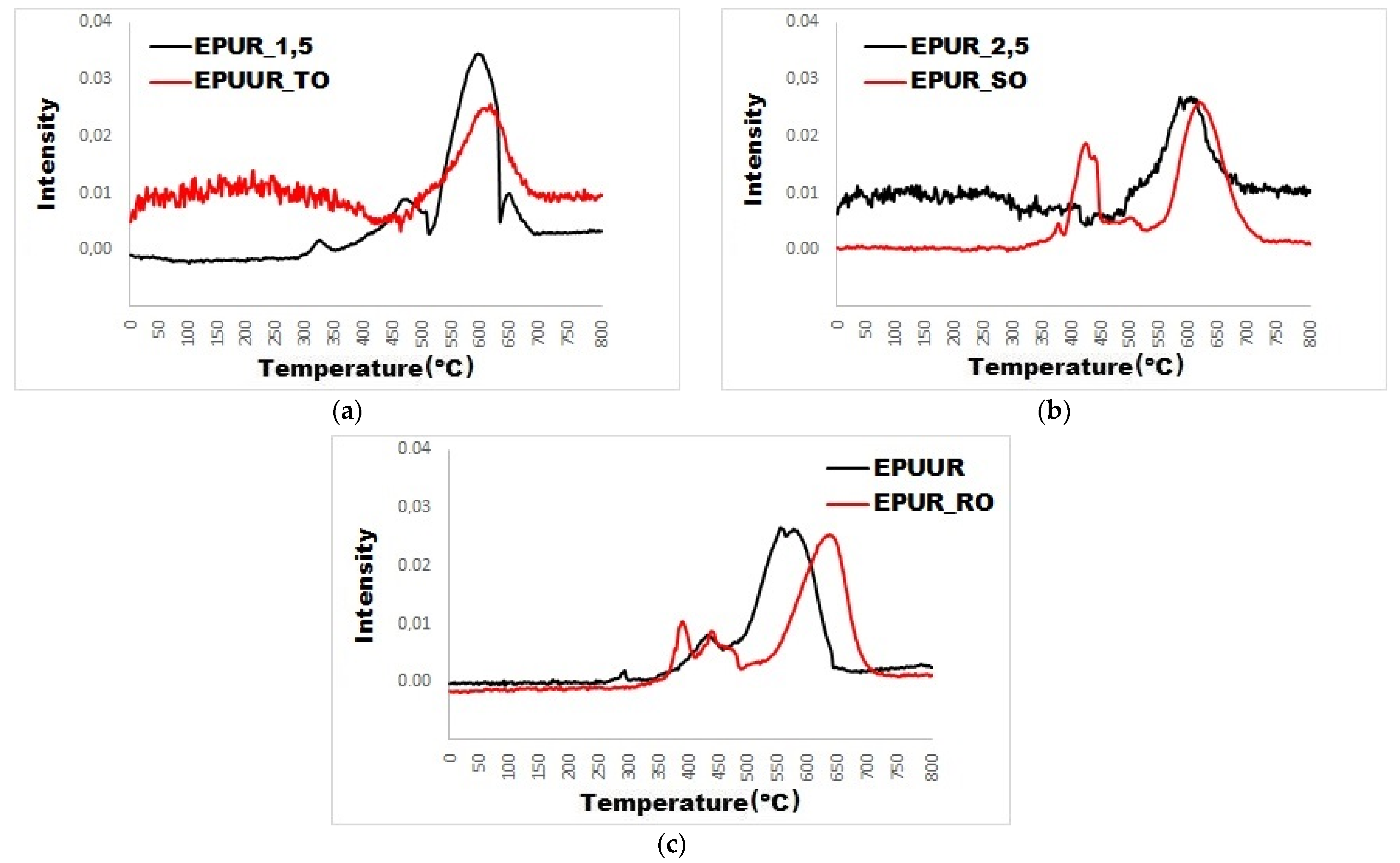

| Sample Designation | Polyol—Amount (mol) | Isocyanate—Amount (mol) | Chain Extender—Amount (mol) | HS (wt%) |
|---|---|---|---|---|
| EPUR_1,5 | PEA—1 | MDI—1.55 | EG—0.5 | 17.6 |
| EPUUR_TO | PEA—1 | MDI—1.55 | TO—0.5 | 21.1 |
| EPUR_2,5 | PEA—1 | MDI—2.55 | EG—1.5 | 23.7 |
| EPUR_SO | SO—1 | MDI—2.55 | EG—1.5 | 33.2 |
| EPUUR | PEA—1 | MDI—1.55 | DYDI—0.5 | 24.5 |
| EPUUR_RO | PEA—0.5/RO—0.5 | MDI—1.55 | DYDI—0.5 | 29.6 |
| Sample Designation | T5% | T1 | m1 | T2 | m2 | T3 | m3 | T4 | m4 | T5 | m5 | R800 |
|---|---|---|---|---|---|---|---|---|---|---|---|---|
| (°C) | (°C) | (%) | (°C) | (%) | (°C) | (%) | (°C) | (%) | (°C) | (%) | (%) | |
| EPUR_1,5 | 293 | - | - | 323 | 18.2 | 376 | 45.4 | 414 | 26.6 | - | - | 7.3 |
| EPUUR_TO | 264 | - | - | - | - | 387 | 36.9 | - | - | 430 | 50.4 | 4.4 |
| EPUR_2,5 | 303 | - | - | 328 | 13.0 | - | - | - | - | 440 | 77.3 | 7.5 |
| EPUR_SO | 294 | - | - | 319 | 16.6 | - | - | 415 | 53.5 | 476 | 21.3 | 5.4 |
| EPUUR | 289 | 298 | 9.5 | - | - | - | - | 400 | 76.8 | - | - | 9.1 |
| EPUUR_RO | 284 | 304 | 10.9 | - | - | 375 | 73.3 | - | - | - | - | 7.9 |
| Sample Designation | T5% | T1 | m1 | T2 | m2 | T3 | m3 | T4 | m4 | T5 | m5 | T6 | m6 | T7 | m7 | R800 |
|---|---|---|---|---|---|---|---|---|---|---|---|---|---|---|---|---|
| (°C) | (°C) | (%) | (°C) | (%) | (°C) | (%) | (°C) | (%) | (°C) | (%) | (°C) | (%) | (°C) | (%) | (%) | |
| EPUR_1,5 | 297 | - | - | 322 | 16.3 | - | - | 400 | 28.4 | 442 | 31.2 | - | - | 561 | 22.7 | 0.9 |
| EPUUR_TO | 292 | 216 | 11.0 | - | - | - | - | 399 | 15.1 | 432 | 51.7 | - | - | 550 | 19.4 | 2.2 |
| EPUR_2,5 | 304 | - | - | 324 | 15.0 | - | - | 401 | 28.0 | 444 | 33.0 | - | - | 559 | 22.2 | 0.7 |
| EPUR_SO | 279 | 199 | 1.7 | 316 | 17.9 | 361 | 8.2 | 384 | 14.5 | 416 | 18.9 | 468 | 14.4 | 570 | 23.4 | 0.6 |
| EPUUR | 310 | - | - | 325 | 8.7 | - | - | 395 | 27.9 | 439 | 38.0 | - | - | 583 | 22.2 | 1.1 |
| EPUUR_RO | 297 | - | - | 326 | 12.9 | 372 | 23.7 | 419 | 17.3 | - | - | 469 | 19.2 | 579 | 24.2 | 0.2 |
| Sample Designation | TTI | Av-HRR | MAHRE | PHRR/tPHRR | THR | EHC | TSR |
|---|---|---|---|---|---|---|---|
| (s) | (kW/m2) | (kW/m2) | (kW/m2s1) | (MJ/m2) | (MJ/kg) | (m2/m2) | |
| EPUR_1,5 | 41 ± 6 | 262 ± 7 | 407 ± 21 | 7.2 ± 1 | 92 ± 8 | 22 ± 1 | 954 ± 19 |
| EPUUR_TO | 81 ± 10 | 95 ± 17 | 170 ± 28 | 2.3 ± 0 | 53 ± 9 | 9 ± 1 | 437 ± 44 |
| EPUR_2,5 | 38 ± 1 | 261 ± 60 | 354 ± 21 | 7.5 ± 1 | 68 ± 4 | 18 ± 1 | 740 ± 25 |
| EPUR_SO | 38 ± 2 | 471 ± 26 | 613 ± 28 | 23. 5 ± 7 | 116 ± 3 | 30 ± 1 | 2367 ± 35 |
| EPUUR | 36 ± 4 | 280 ± 26 | 398 ± 39 | 7.8 ± 0 | 86 ± 3 | 22 ± 0 | 1134 ± 92 |
| EPUUR_RO | 33 ± 0 | 73 ± 5 | 180 ± 10 | 4.0 ± 0 | 41 ± 2 | 10 ± 0 | 150 ± 10 |
Publisher’s Note: MDPI stays neutral with regard to jurisdictional claims in published maps and institutional affiliations. |
© 2021 by the authors. Licensee MDPI, Basel, Switzerland. This article is an open access article distributed under the terms and conditions of the Creative Commons Attribution (CC BY) license (https://creativecommons.org/licenses/by/4.0/).
Share and Cite
Mizera, K.; Sałasińska, K.; Ryszkowska, J.; Kurańska, M.; Kozera, R. Effect of the Addition of Biobased Polyols on the Thermal Stability and Flame Retardancy of Polyurethane and Poly(urea)urethane Elastomers. Materials 2021, 14, 1805. https://doi.org/10.3390/ma14071805
Mizera K, Sałasińska K, Ryszkowska J, Kurańska M, Kozera R. Effect of the Addition of Biobased Polyols on the Thermal Stability and Flame Retardancy of Polyurethane and Poly(urea)urethane Elastomers. Materials. 2021; 14(7):1805. https://doi.org/10.3390/ma14071805
Chicago/Turabian StyleMizera, Kamila, Kamila Sałasińska, Joanna Ryszkowska, Maria Kurańska, and Rafał Kozera. 2021. "Effect of the Addition of Biobased Polyols on the Thermal Stability and Flame Retardancy of Polyurethane and Poly(urea)urethane Elastomers" Materials 14, no. 7: 1805. https://doi.org/10.3390/ma14071805
APA StyleMizera, K., Sałasińska, K., Ryszkowska, J., Kurańska, M., & Kozera, R. (2021). Effect of the Addition of Biobased Polyols on the Thermal Stability and Flame Retardancy of Polyurethane and Poly(urea)urethane Elastomers. Materials, 14(7), 1805. https://doi.org/10.3390/ma14071805









